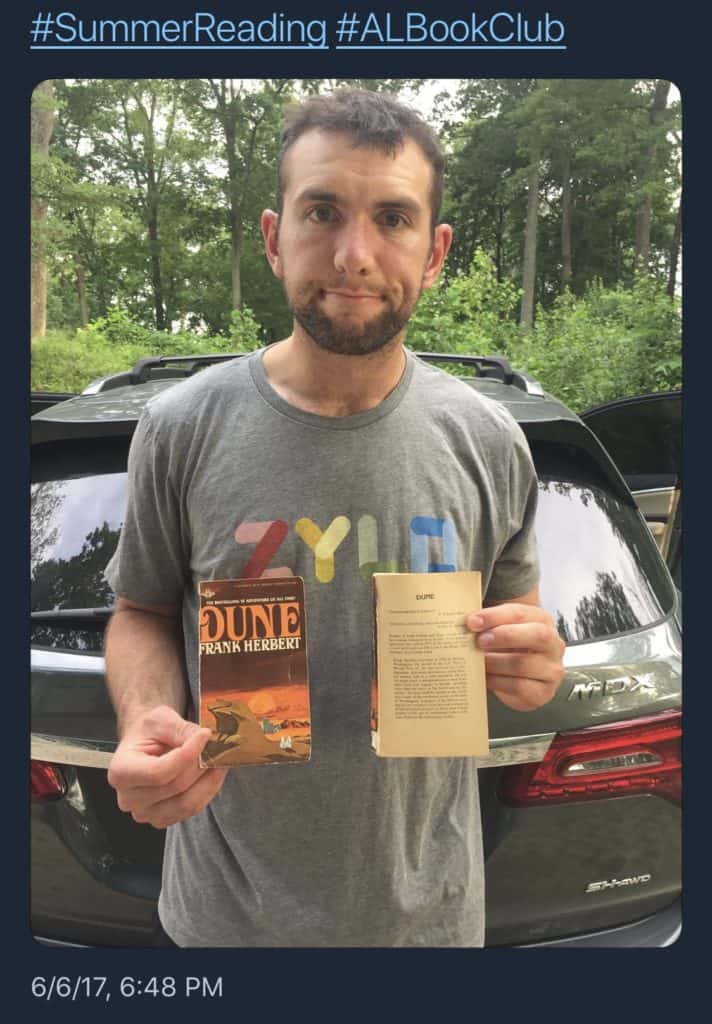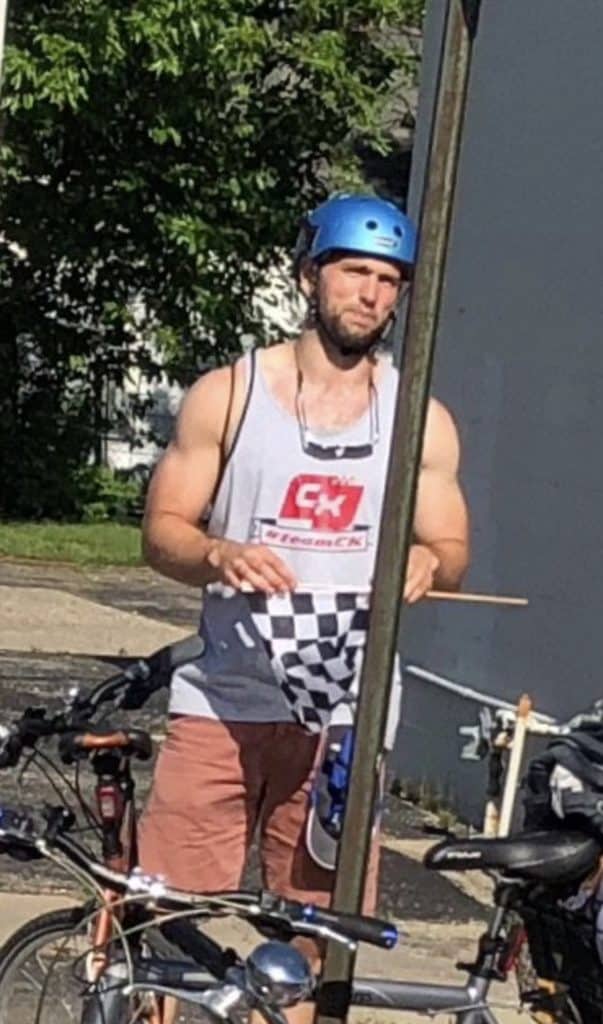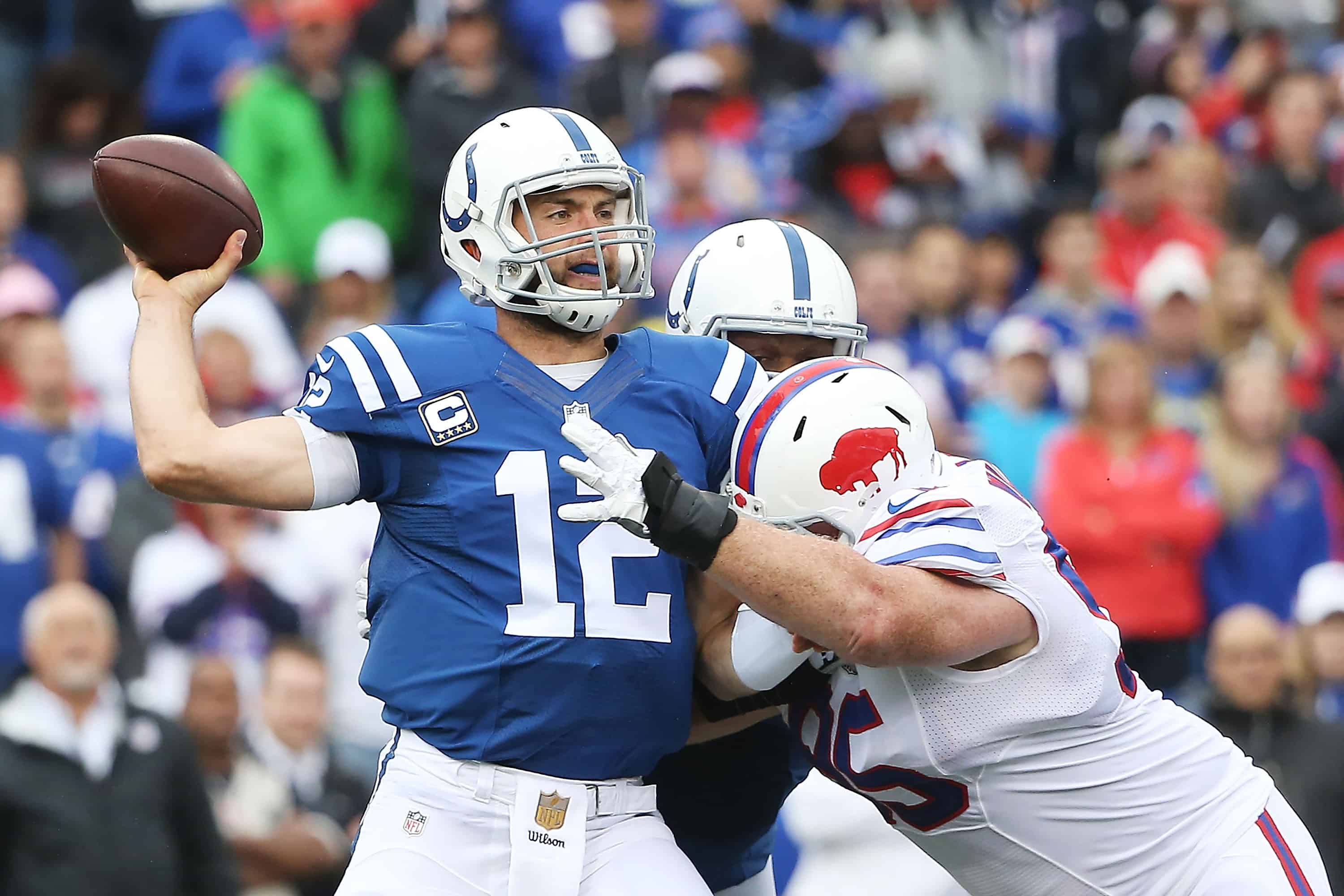Andrew Luck started his career relatively healthy. He played all 16 games his first three years in the NFL.
But during the 2015 season, Luck missed two games due to a shoulder injury. After the injury, Luck returned to play, but was playing through torn cartilage in two ribs, an injury which was so painful he required pain-killing injections in order to play. He also missed the final seven regular season games after suffering a lacerated kidney.
He returned to the field in 2016, but was listed on the injury report with various injuries for over half of the season. As it turned out, Luck tore his labrum in his throwing shoulder and played most of the season dealing with the pain. He also sustained injuries to his right elbow and thumb, as well as his left ankle. And suffered at least one concussion. He said repeated hits over the course of the season continued to make his throwing shoulder worse. It bothered him so much that he decided to undergo surgery on it in January of 2017.
His rehab lasted much longer than expected. It wasn’t until early August 2017 that doubts emerged about Luck’s Week 1 availability. By mid-August, his Week 1 availability was “in question”. Two weeks before their opener, then head coach Chuck Pagano said there was “no timetable” for Luck’s return. And on August 31st, Luck was declared “unlikely” to play in Week 1.
Luck would miss the entire 2017 season, rehabbing his injury.
Luck became extremely thin rehabbing in 2017. He was a literal shadow of the man he used to be.

It wasn’t until mid-2018 that Luck began to regain his appearance.

Luck went from the final game of the 2016 season to the first game of the 2018 season, a span of 616 days, without throwing a football in an NFL game.
Imagine 616 days of rehab for a player who holds the weight of his entire city on his shoulders. That had to be incredibly depressing.
Luck returned at the start of the 2018 season, and recorded his career-best passer rating, his career-best QBR, and a career-best completion rate. He won Comeback Player of the Year. He was healthy and happy entering 2019.
But Luck suffered a mysterious calf or ankle injury this offseason. He said he’s been in pain for weeks, and there isn’t any progress. He is trying to rehab it, but it’s clearly not responding to treatment.
Shockingly, Andrew Luck retired on Saturday night at the age of 29.
He shared many reasons, but key among them was the burden of the injuries he sustained, and “four years of this ‘injury -> pain -> rehab’ cycle.”
At his press conference, Luck talked about the 2016 season. He played through a lot of pain that season. He reflected back to that season, saying:
“I've been stuck in this process. I haven't been able to live the life I want to live. It’s taken the joy out of this game and after 2016, when I played in pain and was unable to regularly practice, I made a vow to myself that I would never go down that path again. I find myself in a similar situation and the only way for me is to remove myself from football and this cycle I've been in. I've come to the proverbial fork in the road and I made the vow to myself that if I ever entered this situation again, I would choose the innocence.”
Luck has also admitted to being a “miserable SOB” in August of 2018, as he was 600 days into rehab and trying to get ready for the season. He said he “was a sad, miserable human. I was not nice to myself, nor was I nice to anyone else. I was nervous. I was scared. I was a miserable SOB to be around.”
It doesn’t take a Stanford graduate to think hard about the ridiculous pain he played through in 2016, and his personal vow to never put himself through that again.
It doesn’t take a Stanford graduate to reflect back the surgery following that season and the 600 days of rehab as he tried to get ready for the 2018 season, being “a sad, miserable human”.
Luck didn’t want to play through persistent pain nor did he want to keep rehabbing injuries as he did for four straight seasons.
Now that Luck has announced his retirement, we can reflect back on how incredible he was as a player. As a passer. As a winner. As a competitor.
Many articles will and should be written to showcase the unbelievable, but far too short, career of Andrew Luck.
But I wanted to focus more on the causes of why he was so often hurt.

As we saw with his latest injury, injuries can happen at any point in time. They can happen during the course of play, during practice, or in the offseason. And they could happen through the fault of no one.
But when it comes to playing the game, what do we also know?
The more you are hit, the more likely you are to be injured.
And unfortunately for Andrew Luck, he played for a general manager who tried to get by without providing him adequate protection for years.
Andrew Luck’s rookie contract ran from 2012-2015. What we know about rookie contracts is they are exceedingly inexpensive, especially for quarterbacks compared to veteran deals.
Andrew Luck was hitting the cap for between $4M and $7M in the four years between 2012 and 2015. As a result, the Colts were in the bottom half of the league in cap space allocated to the quarterback position.
A perfect position to be in. Because it allows the GM to spend money on other positions.
But Colts GM Ryan Grigson became greedy. After compiling 11-5 records and making the playoffs in each of the 2012 and 2013 seasons, Grigson began shifting cap dollars from the offensive side of the ball to the defensive side of the ball.
The 2014 Colts were the second-least expensive offense and the fifth-most expensive defense.
Grigson was funneling cap dollars away from many offensive positions, including the offensive line, and shifting them to the defense.
By 2015, the Colts had the most expensive defense and the fourth least expensive offense.
Grigson was signing free agent upon free agent on the defensive side of the football. And free agents are expensive.
The offense was cheap, and the single cheapest unit on the offense in 2015? The offensive line.
It was the fourth-cheapest offensive line in the NFL.
Two of the five starters on that 2015 offensive line were undrafted free agents.
Two others were Hugh Thornton and Jack Mewhort. Both Thornton and Mewhort were drafted by Grigson. Neither lasted past their rookie deals (one was cut before the deal ended). Both flopped out of the NFL after the Colts were done with them.
It was behind that line in 2015 that Andrew Luck’s career began to be shortened.
For the first time in his career, Luck was injured and missed time. Substantial time due to substantial injuries.
In 2015, Luck played only seven games.
Not only did Grigson acquire expensive free agent after expensive free agent for the defensive side of the ball, which created less spending available for the offense, he simply didn’t draft offensive linemen.
During the entirety of the four years of Luck’s rookie contract, Grigson drafted a total of three offensive linemen before the seventh round:
- Hugh Thornton (cut before his rookie deal expired and never played again in the NFL)
- Khaled Holmes (cut before his rookie deal expired and never played again in the NFL)
- Jack Mewhort (never played again in the NFL after his rookie deal expired)
You can argue that the style in which Andrew Luck plays makes him more likely to be injured, and that is true.
You can argue that a player can be injured at any point in time, whether he has a good or bad offensive line, and that is true.
But what you can’t argue is that Ryan Grigson’s spending of cap dollars came to a head in 2015, producing subpar talent along the offensive line (one of the cheapest in the NFL).
And Grigson’s decisions produced measurable results in terms of volume of hits and sacks on Andrew Luck in that 2015 season (via Pro Football Focus):
2012: 38.1% pressure rate, 8% sack + hit rate, 41 sacks
2013: 37.5% pressure rate, 6% sack + hit rate, 32 sacks
2014: 36.2% pressure rate, 5% sack + hit rate, 27 sacks
2015: 40.2% pressure rate, 14% sack + hit rate, 34 sacks (extrapolated to a 16-game season)*
*Played only 7 games due to injury
Luck played in 2016, but was once again a man running for his life, as the stats clearly show:
2016: 44.3% pressure rate, 9% sack + hit rate, 44 sacks (extrapolated to a 16-game season)
Luck was pressured even more frequently than he was in 2015, and was sacked the most often of his career. A hit early in the season to his throwing shoulder resulted in a torn labrum, which he played through all season long. He also sustained injuries to his right elbow and thumb, as well as his left ankle and a concussion.
Ryan Grigson was fired after that 2016 season.
All told, under Grigson’s watch, Andrew Luck was pressured on 1,111 drop backs during 70 games, for an average of 16 pressured drop backs per game.
Under Grigson’s watch (2012-2016), Luck was the most pressured and most hit quarterback in the NFL.
Insane.
Ryan Grigson killed Andrew Luck's career.
Pressured 16 times per game under Grigson's watch, MOST in NFL & hit MOST of any QB.
From 2012-2015, Grigson drafted just 3 O-Linemen before rd 7:
•Hugh Thornton (trash)
•Jack Mewhort (trash)
•Khaled Holmes (trash)So sad. https://t.co/61HtIEqd8N
— Warren Sharp (@SharpFootball) August 25, 2019

It doesn’t take a Stanford graduate to see the less Grigson spent along the offensive line, the less talent the Colts had to protect Luck, which resulted in more hits and persistent injuries.
While Grigson was fired before the 2017 season, the toll on Andrew Luck wasn’t done.
Because of the brutal beating he took in 2016 and his choice to play through a torn labrum, Luck missed the entire 2017 season rehabbing.
He (barely) returned in time for the 2018 season, but when he did, he was greeted by new GM Chris Ballard and head coach Frank Reich.
Ballard made it a point to put Luck behind a re-built offensive line. Ballard used a first round pick on guard Quenton Nelson and a second round pick on tackle Braden Smith. Ballard picked up guard Mark Glowinski off waivers the prior December.
These three new acquisitions paired with center Ryan Kelly (drafted in 2016) and left tackle Anthony Castanzo (drafted pre-Grigson in 2011) formed the best offensive line of Luck’s career.
And thanks Ballard’s personnel decisions and Reich’s coaching, for the first time in his NFL career, Luck was pressured on less than 30% of his drop backs.
Compare these 2018 statistics to prior years:
2018: 29.5% pressure rate, 3% sack + hit rate, 18 sacks
*2016: 44.3% pressure rate, 9% sack + hit rate, 44 sacks (extrapolated to a 16-game season)
*2015: 40.2% pressure rate, 14% sack + hit rate, 34 sacks (extrapolated to a 16-game season)
*2014: 36.2% pressure rate, 5% sack + hit rate, 27 sacks
*2013: 37.5% pressure rate, 6% sack + hit rate, 32 sacks
*2012: 38.1% pressure rate, 8% sack + hit rate, 41 sacks
* Grigson was GM
His performance in 2018 won Andrew Luck Comeback Player of the Year.
And the marriage of Luck, Ballard and Reich appeared like it had an extremely high ceiling. They were one of the favorites to win the Super Bowl in 2019.
But no longer. The shocking news of Luck’s retirement was sudden.
But Luck made it clear at his press conference, it wasn’t just this injury. It was the culmination of all the other injuries and all the other rehab over the last four years (2015, 2016, 2017 and 2018, heading now into 2019).
It was the vow he made to himself in after the 2016 season, to not play through that same persistent pain again. It was the way his 600+ day rehab made him feel as a person, and his desire not to deal with that for who knows how many more weeks and months until his current injury healed itself.

If Andrew Luck never had prior “cycles” of injury -> pain -> rehab for years in a row, he likely doesn’t retire now.
If Andrew Luck wasn’t hit as often, he likely doesn’t have as many prior “cycles” of injury.
If Andrew Luck was better protected, he likely doesn’t get hit as often.
If Ryan Grigson paid closer attention to putting talent along the offensive line, Andrew Luck is better protected.
Thus, if Ryan Grigson paid closer attention to putting talent along the offensive line, Andrew Luck likely doesn’t retire now.
All of that is true.
As is the fact that providing Andrew Luck better talent along the offensive line under Grigson’s watch doesn’t unequivocally ensure Luck is any healthier today than he is.
We can’t sit here today and blame Luck’s early retirement entirely on Ryan Grigson. Things happen, and Luck plays a brutal, violent sport.
But we can shed light on the way that Grigson managed the construction of the Colts. His decisions to spend in a certain manner absolutely impacted the career of Andrew Luck.
They are inseparable.
Under Grigson’s watch, over a five-year span, he spent less and less along the offensive line, provided Luck with weaker and weaker talent for protection, and it resulted in Luck being the most pressured and hit quarterback in the NFL.
With quarterbacks being the single most important position in the NFL, it’s important to ensure that they are as protected as possible. But that protection is partially owned by the quarterback himself, in terms of his decision making. And that protection is partially owned by the play caller, with the plays he calls, the progressions and reads he has designed, and the ability (or lack thereof) he gives the quarterback to audible.
Younger quarterbacks are entering the NFL and are being given the keys to the future of most franchises. It’s vital that the entire organization realizes the ramifications of injury to this critical position.
Between the GM providing talent to protect him, play callers designing an offense that benefits the passer, and the quarterback himself controlling what he can, we hopefully see more top passers play well into their 40s.
It’s a shame that one of them won’t be Andrew Luck.
















